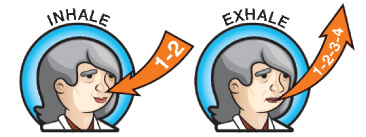What is a 'Top Breather'?
This article was reviewed by Senior Director of Community Engagement and COPD360social Community Manager, Bill Clark, as well as certified staff Respiratory Therapists on February 23, 2020.
Dear COPD Coach,
I recently heard the term top breather. What does this mean?
-Breath Question
Dear Breath,
The term top breather is a term that indicates an inability to take deep breaths; breathing in a way that seems to use only the top parts of the lungs. This is somewhat common in people with COPD. It occurs because of hyperinflation of the lungs which does not allow us to expel all the air our lungs are holding.
When our lungs are hyperinflated (over inflated or too large) we are only able to expel a small amount of air, which in turn means that we can only take in smaller amounts of air. The problem with this is that the air in the lungs that remains trapped becomes “stale” and therefore not able to keep up our oxygen levels. Top breathing especially becomes a problem when we get short of breath and breathe rapidly because we’re hungry for air. The other problem with top breathing is that it can result in a retention on CO2 further triggering the feeling that we are short of breath. Because top breathing takes less effort, it is very easy to fall into doing it regularly which in turn causes problems with our oxygenation.
 It is very important for a person with COPD to practice breathing techniques to optimize the amount of oxygen our injured lungs are able to process. Some of these techniques might be familiar to you, but always worth mentioning. Be advised that the following is for information only. Always consult your healthcare professional before starting any new technique or exercise.
It is very important for a person with COPD to practice breathing techniques to optimize the amount of oxygen our injured lungs are able to process. Some of these techniques might be familiar to you, but always worth mentioning. Be advised that the following is for information only. Always consult your healthcare professional before starting any new technique or exercise.
- When you first start feeling that you are becoming short of breath, begin pursed lips breathing. The technique for pursed lips breathing is while sitting in a comfortable position inhale as deeply as you can through your nose. Put your lips in a position like you would to whistle, then blow the air out slowly for about twice as long as it took to breathe in. A good rule of thumb is to breathe in for two counts and out for four counts. Never force your air out when you exhale, just keep your lips together and let it go. This technique will allow you to slow down your breathing as well as allowing the lungs time to process the oxygen. This technique should be used throughout the day even if you are not feeling short of breath. I do it a lot when I am watching TV or just relaxing, and I immediately notice improved oxygen.
- A second exercise is diaphragmatic breathing. This is an exercise you should do at least 3 times a day and will help strengthen the diaphragm resulting in better function. The exercise is accomplished by lying on your back. Your knees should be bent with one hand placed on your abdomen and the other on your chest. Inhale and exhale as deeply as you can while keeping your chest still, using the stomach to breathe. The important thing is to not allow ourselves to get into rapid breathing because with COPD that means that we are top breathing. In most cases just makes the shortness of breath worse. Make a conscious effort to slow your breathing down before we actually get short of breath. Utilizing the pursed lips breathing technique when exercising or exerting will result is better performance and less shortness of breath.
I hope this answers your question.
Best regards,
The COPD Coach
Ask the Expert is aimed at providing information for individuals with COPD to take to your doctor, and is not in any way intended to be medical advice. If you would like to submit a question to the Coaches Corner email us at coachescorner@copdfoundation.org. We would love to hear your questions and comments. You can address your emails to The COPD Coach.